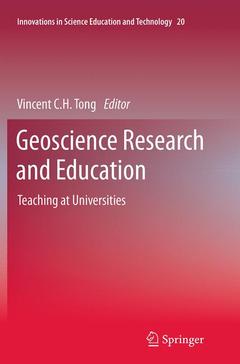Description
Geoscience Research and Education, 2014
Teaching at Universities
Innovations in Science Education and Technology Series, Vol. 20
Language: English
Subject for Geoscience Research and Education:
Publication date: 08-2016
Support: Print on demand
Publication date: 09-2013
304 p. · 15.5x23.5 cm · Hardback
Description
/li>Contents
/li>Comment
/li>
Focusing on geoscience, this book applies a uniquely cross-disciplinary perspective to its examination of the relationship between scientific research and teaching at universities. Contributions show how the use of technology and innovative pedagogical design allows students at different stages of their university studies to develop skills and experience in geoscience research. The book offers wide-ranging insight from academics in geoscience, science education and higher education policy and pedagogy, as well as from students and industry experts.
The opening section sets the context, with a chapter on teaching and research in the contemporary university by a world-leading academic in higher education, and an essay by the editor on the case of moving from research-implicit to research-enhanced teaching. Part Two addresses the research-teaching nexus in geoscience, offering chapters entitled The Challenge of Combining Research and Teaching: A Young Geoscientist?s Perspective; Teaching on the High Seas: How Field Research Enhances Teaching at All Levels; Curricula and Departmental Strategies to Link Teaching and Geoscience Research; and Geoscience Internships in the Oil and Gas Industry, among others. In Part Three, the use of technology is discussed in chapters such as Using Interactive Virtual Field Guides and Linked Data in Geoscience Teaching and Learning; and Towards Technology- and Research-enhanced Education (TREE): Electronic Feedback as a Teaching Tool in Geoscience. The Program Design section includes chapters on Introducing University Students to Authentic, Hands-on Undergraduate Geoscience Research, and the opportunity to link research and teaching in students? final projects and more.
Geoscience Research and Education: Teaching at Universities is a useful resource for understanding the research-teaching nexus and how it has been implemented in different types of universities and in different countries. Science academics seeking to integrate research into teaching will find the book highly relevant to their work. The emphasis on using technology as a means to link research and teaching will be of great interest and practical benefit to learning technologists, science educators and university policymakers.
Together with the companion volume Geoscience Research and Outreach: Schools and Public Engagement, this book showcases the key role that geoscience research plays in a wide spectrum of educational settings.
PART I: INTRODUCTION.- 1. The context.- From research-implicit to research-enhanced teaching: A geoscience perspective, Vincent C. H. Tong.- Teaching and research in the contemporary university, Simon Marginson.- PART II: RESEARCH-TEACHING NEXUS IN GEOSCIENCE.- 2. Perspectives.- The challenge of combining research and teaching: A young geoscientist’s perspective, Laura J. Cobden.- Incorporating research into teaching geosciences: the Masters student’s perspective, Barbara McNutt.- Teaching on the High Seas: How Field Research Enhances Teaching at All Levels, Ken C. Macdonald.- 3. Promoting research-enhanced teaching.- Curricula and departmental strategies to link teaching and geoscience research, Alan Jenkins.- The Role of scholarly publication in geocognition and discipline-based geoscience education research, Julie Libarkin.- Geologic Displays as Science and Art, Marjorie A. Chan.- Teaching Geoscience Research to Adult Undergraduates and Distance Learners, Hilary Downes.- Geoscience Internships in the Oil and Gas Industry: A Winning Proposition for both Students and Employers, Rolf V. Ackermann and Lucy MacGregor.- PART III: PEDAGOGICAL EXAMPLES.- 4. Use of technology.- Integration of Enquiry Fossil Research Approaches and Students’ Local Environments within Online Geoscience Classrooms, Renee M. Clary and James H. Wandersee.- Embedding Research Practice Activities into Earth and Planetary Sciences Courses Through the Use of Remotely Operable Analytical Instrumentation, Jeffrey G. Ryan.- Using Interactive Virtual Field Guides and Linked Data in Geoscience Teaching and Learning, Tim Stott, Kate Litherland, Patrick Carmichael and Anne-Marie Nuttall.- GEOverse – An undergraduate research journal: ResearchDissemination within and beyond the Curriculum, Helen Walkington.- Towards technology- and research-enhanced education (TREE): Electronic feedback as a teaching tool in geoscience, Vincent C. H. Tong.- 5. Programme design.- Introducing university students to authentic, hands-on undergraduate geoscience research in entry-level coursework, Laura Guertin.- Engaging first-year students in team-oriented research: The Terrascope learning community, S. A. Bowring, A. W. Epstein and C. F. Harvey.- Students’ final projects: an opportunity to link research and teaching, Dolores Pereira and Luis Neves.- Teaching Environmental Sciences in an International and Interdisciplinary Framework: from Arid to Alpine Ecosystems in NE Spain, D. Badía, N. Bayfield, A. Cernusca, F. Fillat and D. Gómez.- The Role of concept inventories in course assessment, Julie Libarkin, Sarah E. Jardeleza and Teresa L. McElhinny.
These books may interest you

Polyhedral Methods in Geosciences 147.69 €



